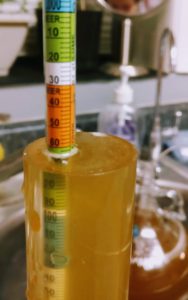Mead #2 – Measuring alcohol production.
After one week in the jug I was ready to take my second gravity reading which will tell us what percentage of alcohol we have so far.
The processes for measuring alcohol production in Mead is the same as it is with beer and wine. The way I use on all of mine will be taking an initial reading with a hydrometer which measures the relative density of liquids and comparing it to a reading during or after fermentation we can use the difference to find how much of the sugar has been converted to alcohol.


I plan to go into more detail in a future article about the uses of the hydrometer and other popular methods but that’s for another day. For now now lets compare the results the original gravity reading for Mead #2 of 1.064 and the new gravity of 1.002.
The original gravity of 1.064 has a potential alcohol production level of 8.4%. I won’t quite hit that level do to a number of other factors, but if 100% of the sugars where converted that would be the approximate alcohol percentage.
Instead of just using the potential to calculate the production of alcohol I use two different popular equations to base the alcohol percentage on, these both compare the original gravity and the present gravity. Note: These readings need to be taken an approximately the same temperature as temperate will cause the readings to vary.
The first equation I use is: (76.08 * (OG–PG) / (1.775-OG)) * (PG / 0.794) which with Mead #2 will give us a alcohol production of 8.37%.
The second equation I use is the most common among home-brewers: (OG–PG)*131.25 on Mead #2 will give us 8.14%.
Both of which OG is the original gravity and PG is present gravity.
Why do I use 2 equations and why are the values different? When I first started brewing I found the first equation on most brewing equipment sites on how to measure the alcohol on a hydrometer. The second equation is the one I found most home-brewer forums using most likely because it’s simple, easy to remember, and easy to calculate. I used both to start with to compare the results they would give, then after a while it was I good check on my math. If I had a result that differed by more than a 1% I knew I needed to recheck my numbers.
After the first week we have a 8.3% mead and technically you can drink it now if you want but it will taste terrible. Trust me time is your friend.
After taking the gravity reading I siphoned Mead #2 into another jug the yeast sitting at the bottom is dead and over time will cause the mead to develop bad flavors so always leave the last bit in the bottom. Now it can continue fermenting while we start the next batch Mead #3.
